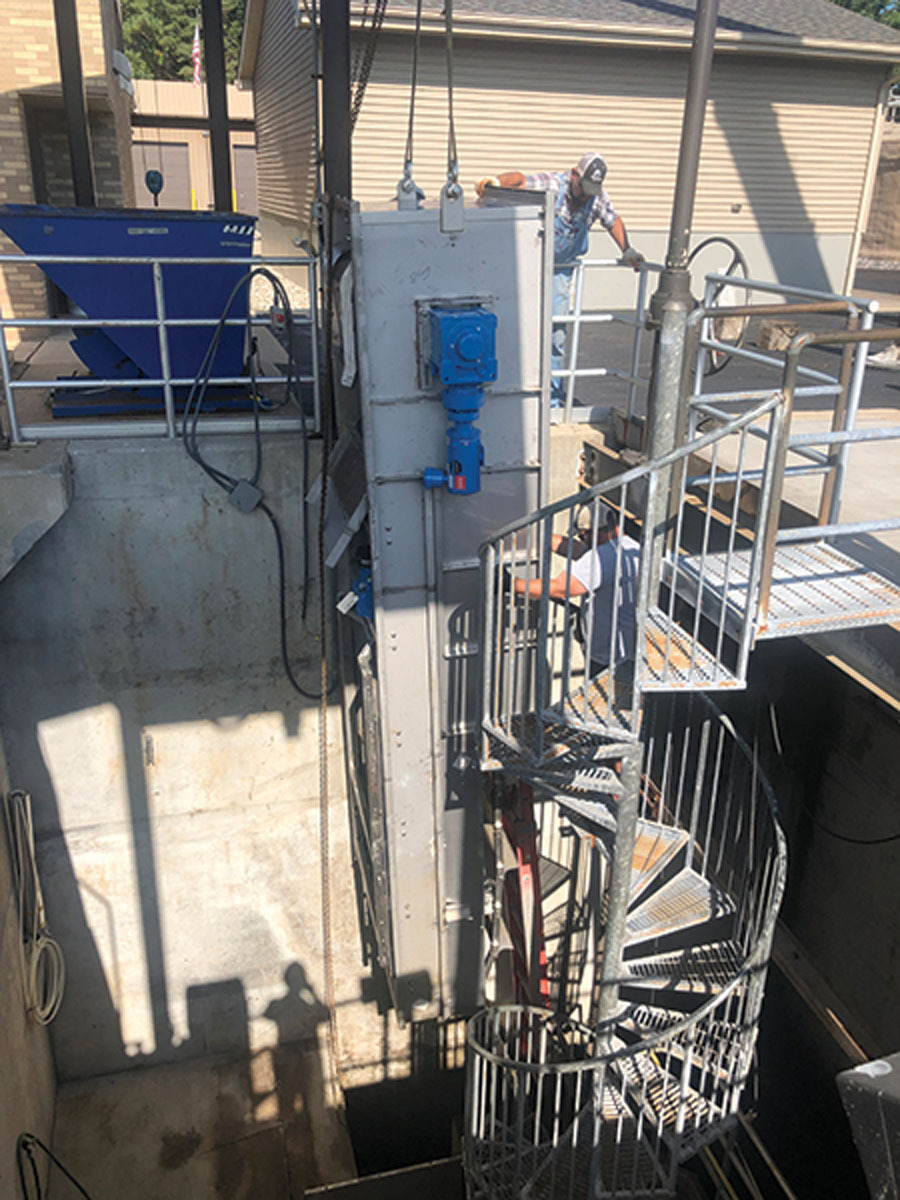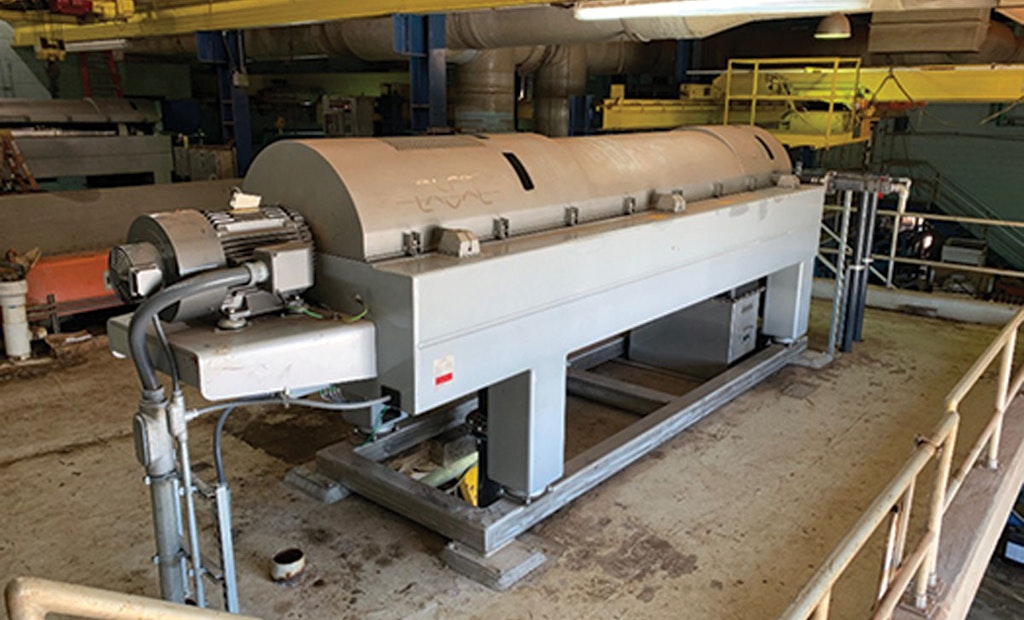Interested in Headworks?
Get Headworks articles, news and videos right in your inbox! Sign up now.
Headworks + Get AlertsModern decanters deliver twice the flow using half the power at water reclamation facility
Problem: A water reclamation facility in the Southeast needed to replace its aging dewatering decanter centrifuges.
Solution: Alfa Laval ALDEC G3-125 decanter centrifuges deliver up to twice the flow and use half the power and less polymer while fitting the existing footprint. The units include a Slimline conveyor, power tubes and features to simplify maintenance. Alfa Laval engineering expertise and partnerships enabled a turnkey project.
Result: The retrofit of the centrifuges without outside engineering saved enough money to allow the purchase and installation of two decanters for the price of one and reduced the project timeline by almost a year. 866-253-2528; www.alfalaval.us

Screens increase plant resilience, adapt to changing flow conditions
Problem: The Saginaw Charter Township (Michigan) Wastewater Treatment Plant handles sewage and stormwater runoff, resulting in dramatic wet-weather flow increases. The 4.65 mgd facility can see peak flows at 20 mgd, including stormwater debris.
Solution: Seeking an innovative screening solution, the plant upgraded to the Duperon FlexRake IQ², which automatically adapts to changing flow. During high flows, the raking speed increase. If speed alone does not satisfy the conditions, the screen opening size changes, improving hydraulic capacity.
Result: Plant operators quickly saw improvement. The screen removes about three times the debris and does so as efficiently at 20 mgd as at 4 mgd. It reacts to flows, preventing backups or slowdowns. Increased debris removal requires more frequent emptying of the collection box, but plant operators view that as a worthwhile trade-off. 800-383-8479; www.duperon.com

Decanters provide smooth operation for military base’s treatment plant
Problem: Northern Wastewater Treatment Plant of Marine Corps Training Base Camp Pendleton in Southern California serves a migratory population of 200,000 people, including 18,000 troops, employees and their families.
Solution: The $66 million plant consolidates all the pump stations and lift stations of 12 treatment plants down to Northern and Southern treatment plants. While the Southern plant kept its older equipment, the Northern plant was outfitted with Flottweg centrifuge decanters and 3.2 MW of solar power with a 2 MW backup generator.
Result: Operator Philip Starks says one person can operate the equipment, which needs minimal maintenance: “You don’t want to continuously have to take things apart and fix them. The plant runs so well, we rarely have issues. The Northern Plant is designed to handle a much larger population, and this could double or even triple easily in the future without breaking capacity.” 859-448-2331; www.flottweg.com

Rotary press helps city create cost savings
Problem: The Fernandina Beach wastewater facility was hauling 2.34 million gallons of wet biosolids annually. Landfill costs were rising and landfill availability was getting tight. Dewatering would reduce biosolids volume by 75%.
Solution: The city evaluated dewatering systems based on safety, maintenance, complexity, space required, loading on the headworks, operator time required and surface area to clean. As a result, the city chose a Fournier Rotary Press.
Result: The press enabled increased wasting to the digesters, improving operation of all process trains. “This system should last well over 20 years and should pay for itself in about seven years of operation,” says John Mandrick, P.E., utilities director. 800-463-6328; www.fournierdewatering.com

Improving digester performance with direct steam injection heater
Problem: A midwestern municipal sewerage district faced significant issues with its acid-phase steam injector units, including frequent plugging, high labor, and parts costs, and disruptions to the digestion process. District staff sought to reduce downtime and operating costs.
Solution: Hydro-Thermal developed an unrestricted flow solution called the Non-Obstructive Heater, allowing larger solids to pass through without causing blockages. The units fit the original footprint with minimal piping modifications.
Result: The system significantly reduced plugging and emergency work orders while optimizing the acid digestion process. This reduced labor and maintenance costs. Without the project, plugging would have continued. The Hydro-Thermal NOH improved digester performance and reduced operating costs. 800-952-0121; www.hydro-thermal.com

High volume dry biosolids storage and outloading system meets restricted height limit
Problem: The South Valley Sewer District’s Jordan Basin Water Reclamation Facility in Riverton, Utah, needed to store and outload almost 400 cubic yards of dried biosolids from a new belt dryer. Local zoning height restrictions prevented a typical silo with truck drive-through loading.
Solution: Jim Myers & Sons designed twin 35-foot-tall silos with NFPA explosion mitigation and low discharge. An en masse conveyor collects and elevates the dry biosolids to a truck loadout station and distributes it via three retractable chutes and a dust-collection system.
Result: The facility has a safe, dust free, non-intrusive means to store dry biosolids and an outloading system for quick efficient truck filling. The installation includes a weigh scale and total system programmable logic controls. 704-554-8397; www.jmsequipment.com

Plant benefits from polyurea-based coating product
Problem: When constructing a new wastewater treatment plant, staff in Warrington, Pennsylvania, knew it was a matter of time before the concrete and metals would begin to break down due to the harsh environment and so chose to coat the exposed surfaces.
Solution: The team chose the OBIC Armor coating system, a multi-layer spray-on application followed by a surfacing layer and finished with another layer of polyurea. It has passed the Severe Wastewater Analysis Testing in accordance with ASTM G210-13. The polyurea also bonds well with materials including concrete, brick, steel and glass and does not crack or fracture.
Result: The coating extended the life expectancy of the structure and added a 10-year warranty on the coating and installation. The city staff had confidence in the product, having used it for manholes and pump stations. 866-636-4854; www.obicproducts.com

Waste-to-energy facility employs decanter technology for dewatering
Problem: The waste-to-energy facility in Charlotte, North Carolina, sought to efficiently dewater solids after anaerobic digestion.
Solution: The facility uses three Pieralisi Jumbo 3 HS decanter centrifuges. Material is pre-processed to remove debris and then aerobically digested. The biogas is scrubbed and used to generate renewable electricity. The biosolids are dewatered in decanter centrifuge made of duplex stainless steel. The scroll inside is made of AISI 316 SS and has tungsten carbide tiles around the flight for durability. Dewatering involves an input of up to 100 gpm at 4-6% solids. The centrifuge produces cake at 22-25% solids that can be used as a fertilizer or soil amendment.
Result: The modular design of the decanter makes it easy to maintain and repair. The unit reliably and efficiently handles biosolids while producing renewable energy. 513-275-4720; www.pieralisi.com

Reliability and space savings make rotary fan press an easy choice for municipality
Problem: Tybee Island, Georgia, has a steady population of approximately 3,000 residents. With a spring/summer tourism influx of approximately 1.7 million people, the amount of wastewater needing treatment drastically increased with higher seasonal flows and no increase in operators.
Solution: In 2012 the city selected the Prime Solution Rotary Fan Press as the solution to their outdated belt filter press. As flows continually increased year over year, they knew they needed to increase their capacity without requiring more operators and within their existing building space. In 2020, they again elected to go with a second Rotary Fan Press skid system, without outside engineering and within the existing building space.
Result: Shari Haynes, plant superintendent, says adding the second press not only cut down time on dewatering, but allowed the city to save money. They went from running 10 to 12 hours per day, seven days a week to eight hours a day, five days a week. She also stated the ease of use and low maintenance allows them to easily train operators and meet plant requirements with less hours required. 269-694-6666; www.psirotary.com

System maintains solids in suspension to prevent grit removal system buildup
Problem: Operators of the Indiana Southport Advanced Wastewater Treatment Plant in Indianapolis sought to eliminate the need to periodically take JS 101 B out of service for cleaning due to grit accumulation.
Solution: A pulsed air system from Pulsed Hydraulics was selected due to its higher mixing energy and better ability to keep or re-suspend solids throughout the entire tank. The system can be operated on a continuous basis or may be operated intermittently, based on operator preference. The system includes 24 bubble forming plates located in the channels and basin. Pulsed Hydraulics supplied three 4-valve mixing panels with Allen-Bradley PLC and two rotary screw 20 hp compressors.
Result: Requirements were met and verified by the customer’s engineer. 800-641-1726; www.phiwater.com

Dewatering process recovers more water for utility
Problem: The Tellico Area Services System, a water and wastewater utility in Maryville, Tennessee, built the Niles Ferry Wastewater Treatment Plant to treat 2 mgd. The original facility used a drying bed to dewatering biosolids, a labor-intensive process requiring manual labor with a backhoe and shovels as often as three times a week.
Solution: The new facility has a Volute Dewatering Press from PWTech that yields much drier biosolid and requires minimal labor and maintenance. It automatically thickens, dewaters and conveys biosolids to a truck container without staff intervention.
Result: Cake from the drying beds contained 13% solids; the dewatering press yields 20% solids. Benefits include reduced landfill fees and reduced emissions from truck hauling, and reduced landfill stress. Other benefits include odor elimination and consistent operation regardless of the weather. 410-238-7977; www.pwtech.us

Restructured air intake system reduces corrosion rate of clarifier drive
Problem: City of Camas (Washington) Wastewater Treatment Facility was experiencing rapid corrosion around a clarifier drive unit.
Solution: The facility hired Rebuild-It Services Group to retrofit the flat tank cover to take in air near the center of the clarifier and exhaust the air in two locations instead of one. The corroded drive was repaired and coated with aliphatic amine epoxy.
Result: Gases no longer escape the tank through the drive unit opening. The rapid corrosion has been corrected and the drive is running smoothly. 888-709-5676; www.rebuild-it.com

Cost savings with screw presses at water reclamation facility are notable
Problem: The Big Creek Water Reclamation Facility, the largest clean-water plant in Fulton County, Georgia, needed additional capacity to accommodate growth.
Solution: A multiphase expansion from 32 mgd to 38 mgd is to be completed mid-2024. A new dewatering building features some of the largest screw presses in North America. It includes two Schwing Bioset FSP 1203 screw presses, each with a 1,200 mm screw diameter for throughput of 2,600 dry pounds per hour of aerobically digested biosolids. These new presses replace five smaller screw presses.
Result: The machines, with high-performance screens, improved dewatering performance and provide significant savings in hauling costs and landfill tipping fees. They reduced electricity usage and maintenance. 715-247-3433; www.schwingbioset.com

Auger heater keeps screw conveyor from freezing
Problem: A new wastewater treatment plant in Dunkirk, New York, was designed with a biosolids auger that extends outside for truck loading. The temperature frequently dips to -20 degrees F. To prevent freezing of wet material, the architect sought a solution to heat the auger.
Solution: The architect specified a Thermo-Tech auger heater. The unit operates in conditions down to -40 degrees F, and its stainless steel, weather-tight construction stands up to harsh elements. It is IP68 rated and thermostatically controlled. Installation was completed on a -15 degree F day and immediately went into action.
Result: The system not only stopped the freezing issue and also dried the biosolids, preventing freezing in the trucks. 304-259-5860; www.beltheater.com






